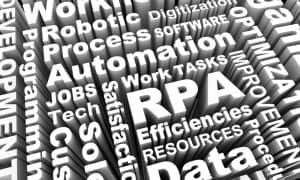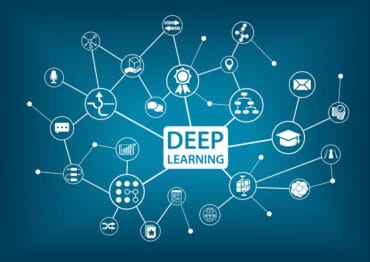
What’s needed is a more intelligent and holistic class of process automation that weaves together a combination of technology capabilities including RPA, machine learning, natural language processing, optical character reader, and other flavors of AI.
It’s difficult to have a conversation about business automation without bringing up the topic of robotic process automation (RPA). This technology has been in the spotlight for a few years, and it continues to generate interest as more businesses seek to improve mundane tasks quickly and with minimal disruption.
See also: Are You Getting the Best Results from RPA?
For those of you not familiar with the technology, RPA solutions—also known as software robots or bots—can be ‘trained’ and deployed at pace to handle the low-value process components that dominate employees’ time. Well-suited to automating repeatable and rule-based tasks, software robots log into applications and systems to extract or edit information, read and write to databases, pull content from the web, move documents and files around, and so forth.
A key reason why RPA has risen in popularity is its ability to work at the presentation layer of legacy systems in much the same way that human users do. This means that RPA is non-intrusive, and there is no need for developers to code or maintain application programming interface (API) integrations.
The upshot? Teams save time, as routine tasks can be executed much faster, more consistently, and accurately than before, with no room for human error. Simultaneously, people are rescued from robotic work, allowing them to focus on other areas of their roles that may add more strategic value to the business.
In the pandemic era, business process roadblocks that have always existed have now been amplified. Siloed legacy systems, slow manual approaches, and admin-heavy workloads are more of a challenge than they ever were, due to budget pressures and dispersed workforces. Many paper-based processes that sufficed before COVID-19 are now impossible to carry out, due to social distancing and remote working arrangements.
Why RPA is having its moment in the sun
Compelled to modernize and innovate ways of working, organizations’ attitudes towards automation are shifting, as they acknowledge the need for technology solutions that can be deployed rapidly to support remote teams and maintain operational efficiency.
The findings of a recent Harris Poll survey revealed that 92% of business leaders recognize the need to enable digital channels and process automation in the workplace. Reasons include the fact that close to 50% are still using manual and paper-based processes; and the fact that 59% are having challenges maintaining operational efficiencies in a distributed environment. Businesses are prioritizing the development of new, automated processes to address COVID-19 realities, connect teams virtually, and support remote employees.
In this context, RPA helps companies to automate manual tasks that rely on legacy systems, without the need for major disruption to existing systems. This approach appeals to a lot of companies who are scrambling to automate quickly and solve pressing challenges.
The exponential growth of RPA
Before the pandemic, RPA was already a hot topic of conversation. During 2018, the robotic process automation market expanded by 63.1% and was rated the fastest-growing enterprise software category globally by analyst firm Gartner.
This year, the momentum has continued. RPA software vendors have attracted substantial investment during 2020, increasing awareness of this technology category. Recent moves by global software corporations include Microsoft’s acquisition of Softomotive to combine the RPA vendor’s desktop automation solution with Microsoft’s Power Automate competencies; and IBM’s acquisition of Brazilian RPA provider WDG Automation, which advances IBM’s AI-augmented automation capabilities.
Additionally, RPA start-up UiPath ranked second among the FT’s fastest-growing companies in the Americas, recently raised $225 million in a Series E round of funding, at a post-money valuation of $10.2 billion.
This is certainly a boom period for RPA. Nevertheless, businesses must be wary about getting caught up in the hype and losing sight of broader, sustained business innovation goals. While RPA offers many tangible benefits, these are often short-term fixes—and it can be challenging for businesses to scale up automation in a stable and agile manner using RPA alone.
Understanding the pitfalls of RPA
While RPA is a great choice for companies that want to achieve immediate automation wins, it can be a one-trick pony. This is because RPA focuses on automating very discrete tasks and helps solve defined problems, often more quickly than trying to achieve broader end-to-end process automation or modernization.
RPA also helps bridge across technology generations with minimal effort initially. But it simply doesn’t provide the extensibility and rich functionality required to tackle all operational roadblocks.
Firstly, it’s important to understand that RPA isn’t an “orchestrator.” In other words: while it can automate certain individual tasks within a process, RPA is not focused on connecting each of those tasks into a fully optimized, seamlessly orchestrated process. If a workflow includes the need for exception handling and other human inputs or involves unstructured data, then RPA is the wrong technology choice.
Secondly, automation using RPA alone is often like encountering an iceberg. You see a small tip of it floating above the waterline (the user interface), which is the point you are automating. But beneath the waterline, there are many existing investments in systems and data. Using RPA will often expose limits or constraints in the underlying process that haven’t been fully digitized, and which may not scale rapidly.
Therefore, to deliver fully on the benefits of digital transformation over the long-term, it’s important to invest in a full vision around digitizing a process. This means identifying flaws in the end-to-end process and finding ways to re-imagine it, rather than simply automating tasks as they exist. Unless companies do things differently, they can’t expect to achieve a profoundly different result.
As an example, people love Amazon’s digital experience for shopping. However, this experience is not the result of Amazon building the best mobile or web app. Rather, this experience is made possible by the fact that Amazon has digitized its entire supply chain, allowing for seamless shopping and same-day or next-day delivery. The use of intelligent automation to create an end-to-end, seamless digital process is the differentiating factor between Amazon and many other retailers.
What’s needed?
If organizations are looking for more than efficiency gains and aim to vastly improve the employee and customer experience, they need more than a one-dimensional technology. The real value comes from a comprehensive and integrated platform with multiple capabilities.
The Harris Poll found that 36% of companies across regions are having difficulty meeting customer satisfaction goals. Nearly all those companies (92%) acknowledge that effective use of process automation and digital transformation is key to addressing this aspect of their business. True digital transformation can’t be achieved through static task automation alone. What’s required is a system that can take the benefits of automation further by orchestrating all the different pieces of a complex process and providing actionable insights on the various process components. This type of approach supports agile business decision making and allows companies to adjust and pivot processes for maximum efficiency and value in the current volatile environment.
These outcomes can be achieved with a modern and intelligent business process management platform, such as a low-code digital process automation (DPA) system. This can easily integrate with RPA and more advanced technologies to build a fully digitally-enabled business. This type of approach also brings humans into the loop during various processes, to support seamless human-machine collaboration.
Taking a holistic approach to automation
The time to think beyond short-term time and cost savings is now. What’s needed is a more intelligent and holistic class of process automation that weaves together a combination of technology capabilities—from RPA to machine learning, natural language processing, optical character reader, and other flavors of AI. This will enable companies to transform more processes, solve more challenges, reinvent the customer experience, and pivot their business models to suit the new requirements of the pandemic era.
A move towards platforms that execute entire business processes with agility and intelligence is likely to shape the RPA industry of the future. We could very well see the other major cloud platforms, including Amazon and Google, following in Microsoft and IBM’s footsteps to acquire or build RPA capabilities to round out their AI competencies.
In the years ahead, business resiliency and adaptiveness will become more important than pure efficiency – and perspectives on RPA and automation, in general, are expected to evolve accordingly.





























